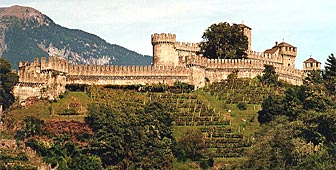On the trail of Leonardo da Vinci in Locarno

Is there evidence of the hand of Leonardo da Vinci at work in Locarno? After two years of research, a historian believes the answer may be yes.
According to scholar Marino Viganò, a bastion of the Visconti Castle, erected in 1507, very well may have been engineered by the great Italian artist.
Viganò’s adventures on the trail of Leonardo da Vinci read like a detective novel. In fact, his investigations have involved painstaking research, evidence gathering and comparative analysis.
His two years of exhaustive studies are documented in a long report which will soon be delivered to the Ticino cultural heritage department.
The report is the result of a labour of love which began almost by chance.
“The object of my research was the ravelin (a defensive outwork, technically a bastion) of the Visconti Castle at Locarno,” explains Viganò. “It is the only part of the castle in private ownership.”
In the summer of 2002, one of the owners invited Viganò to take a look at the ravelin.
“I immediately realised this was something out of the ordinary. Not only because it was out of keeping with the style of the rest of the castle, but because it was of later construction than the fortress as a whole.”
Why should a castle which historians thought was completed at the end of the 15th century comprise a bastion with 16th-century features? And who was responsible for commissioning and constructing it?
These and similar questions were the starting point for Viganò’s investigation.
Locarno fortified
The characteristics of the bastion suggested two possible periods for its construction: the French occupation of the Locarno district from 1499 to 1513, or the period of Swiss rule between 1513 and 1532 (when the castle was demolished and the existence of a Rafellin recorded).
A search of the archives confirmed that the first period was the correct one.
“From the very few extant documents from the period of Swiss rule, we discovered that the bastion was constructed during the French occupation, between 1499 and 1513,” comments Viganò.
It transpired that the order to fortify Locarno was issued in Milan by the “grand maître”, the French courtly title borne by Charles II of Amboise from 1502 to 1511, the year of his death.
This further narrowed the period during which the ravelin could have been built.
Other documents revealed that the entire dukedom of Milan was fortified with similar bastions, and all in the same year: 1507.
And all this work was done under the orders of Charles of Amboise. “It was therefore part of a general process of fortification,” Viganò says.
“At the time Locarno was possibly the most vulnerable Milanese stronghold, therefore Charles may have given special priority to its fortification when, according to the chroniclers, he paid a visit to Bellinzona between July 6 and 22, 1507.”
da Vinci
With the issue of timing settled, Viganò now turned his attention to another question: the engineering of the bastion.
“It is pentagonal in shape, with two sides facing outwards, two laterally, and a neck connecting it to the 15th-century tower of the castle.
The structure includes four embrasures, each with a chimney to evacuate the smoke and flames from the artillery pieces, which would otherwise have suffocated the gunners,” he says.
“The other bastions constructed in 1507 in the dukedom of Milan are of more antiquated type.”
At the time, more modern technology of this kind was restricted to a few places in central Tuscany.
Advanced engineering
So what was such an advanced piece of engineering doing in Lombardy?
Following a hunch recorded in 1894 by the Ticino medieval historian Johann Rudolf Rahn, Viganò’s thoughts turned to the only military engineer capable of constructing such a sophisticated defence work, albeit far from his native Tuscany.
“In 1507, there was only one Florentine in Milan with the requisite knowledge: Leonardo, who had already performed military engineering work for Duke Ludovico Maria Sforza,” Viganò says.
“Before leaving the city in 1499 he had also given the French drawings of two similar ravelins for the Castello Sforzeso in Milan, which were completed in January 1500.”
The pieces of Viganò’s mosaic were falling into place, without his having to invent or speculate.
“It is true there are no documents which prove the authorship of the bastion beyond a doubt,” Viganò admits.
“Partly because the historical record is often incomplete. But the totality of my research, which is still on-going, points to this as the most reasonable conclusion.”
Viganò’s work has been welcomed by two experts: Domenico Taddei, chairman of the scientific committee of the Italian Castles Institute, and Pietro Cesare, a specialist in Leonardo’s work as a military architect.
swissinfo, Françoise Gehring in Locarno
Leonardo’s notebooks, dated by scholars to between 1487 and 1490, contain studies for five-sided bastions.
The French adopted his designs for Milan’s Castello Sforzesco in 1499, seven years before the Locarno bastion was built.
Plans to fortify Locarno had already been adopted in 1500.
Marino Viganò, who lectures on military architecture in Milan, will officially present the results of his research on February 5 in Locarno.

In compliance with the JTI standards
More: SWI swissinfo.ch certified by the Journalism Trust Initiative









You can find an overview of ongoing debates with our journalists here . Please join us!
If you want to start a conversation about a topic raised in this article or want to report factual errors, email us at english@swissinfo.ch.